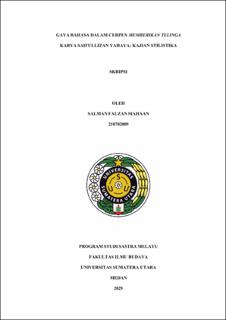| dc.description.abstract | This study examines the language style in the Collection of short stories (Giving Ears) by Saifullizan Yahaya using a stylistic approach. Literary language is an important element in literary works because it reflects the Author's creativity and aesthetics in conveying deep meaning. Collection of short stories (Giving Ears) highlights the theme of alienation and human relationships in modern life, which is expressed through the use of distinctive and meaningful language. This study aims to describe the use of rhetorical and figurative language styles in the short story. This study uses a descriptive qualitative method with a stylistic approach based on the theory of language styles proposed by Keraf (2006). Data were collected through an in-depth analysis of the short story text to identify various forms of rhetorical and figurative language styles used by the Author. The results of the study show that in the short story Giving Ears there are 81 uses of rhetorical language styles, including Alliteration (9), Assonance (8), Anastrophe (5), Apophasis or Preterisio (6), Apostrophe (1), Asyndeton (1), Polysendeton (2), Chiasmus (4), Ellipsis (3), Euphemismus (2), Litotes (3), Histeron Proteron (4), Pleonasm and Tautology (3), Periphrasis (3), Prelepsis or Anticipation (3), Erotesis or Rhetorical Questions (5), Sylepsis and Zeugma (3), Correction or Epanortesis (3), Hyperbole (7), Paradox (4), and Oxymoron (2). Meanwhile, 70 uses of figurative language styles were also found, including Similarity or Simile (8), Metaphor (7), Allegory, Parable and Fable (8), Personification or Prosopopoeia (7), Allusion (6), Eponym (1), Epithet (4), Synecdoche (5), Metonymy (5), Antonomasia (1), Hypalase (2), Irony, Cynicism and Sarcasm (8), Satire (2), Inuendo (4), Antiphrasis (1), and Pun or Paromasia (1). From the findings above, the most figurative language styles are found in rhetorical language styles, while the most varied language styles are found in Rhetorical language styles that is Alliteration. Thus, this study provides new insights into the richness of language in contemporary Malay short stories and the importance of stylistic studies in understanding the aesthetics of literary works. | en_US |


